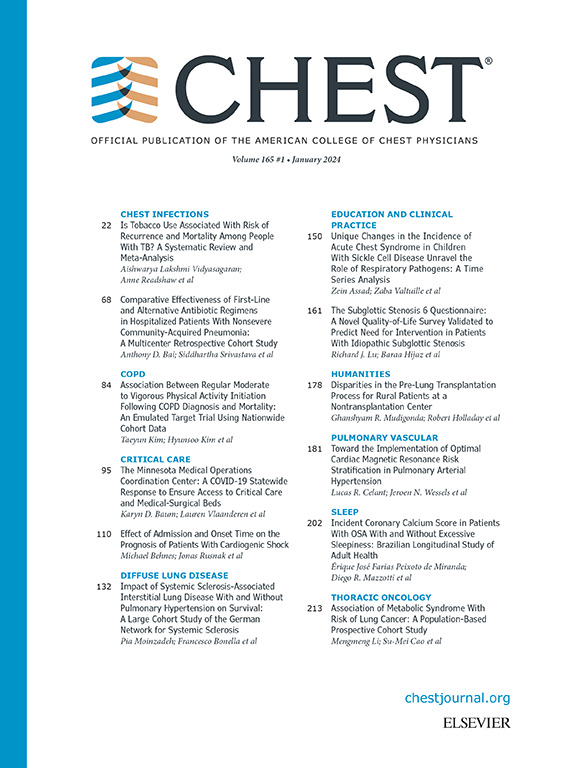Discriminative Accuracy of the Simplified Spirometry for Identifying Spirometry-defined Chronic Obstructive Pulmonary Disease in Community.
IF 9.5
1区 医学
Q1 CRITICAL CARE MEDICINE
引用次数: 0
Abstract
BACKGROUND Low spirometry testing rate for screening of chronic obstructive pulmonary disease (COPD) is partly attributed to complex procedures, stringent quality control requirements, and long examination times. Simplifying the spirometry protocol may increase the feasibility of COPD screening in community settings. RESEARCH QUESTION Does the simplified spirometry protocol have high diagnostic accuracy and time efficiency in screening for COPD? STUDY DESIGN AND METHODS We designed a community-based, cross-sectional diagnostic study. Participants completed spirometry tests using both simplified and routine protocols. Routine spirometry was defined by three maneuvers meeting acceptability and reproducibility criteria according to international standards, while simplified spirometry required only the first acceptable maneuver. The primary outcome was the diagnostic accuracy of prebronchodilator simplified spirometry for identifying spirometric COPD (post-bronchodilator forced expiratory volume in 1 second/forced vital capacity<0.70) measured by the area under the receiver operating characteristic curve (AUC). Secondary outcomes included positive predictive value (PPV), negative predictive value (NPV), sensitivity, specificity, examination time, and consistency of spirometry indicators between the two protocols. RESULTS Out of 632 screened participants, 619 were analyzed. The prebronchodilator simplified spirometry demonstrated high diagnostic accuracy (AUC: 0.972 [95%CI: 0.955-0.983]), with a PPV of 77.4% (95% CI: 72.3-82.5), NPV of 98.1% (95% CI: 96.6-99.5), sensitivity of 96.6% (95%CI: 94.1-99.1%) and specificity of 86.0% (95%CI: 82.6-89.3%) for identifying spirometric COPD. The average examination time was significantly shorter with prebronchodilator simplified spirometry compared with postbronchodilator routine spirometry (2.8±2.2 minutes vs. 32.1±5.4 minutes; difference: 29.3 minutes [95%CI: 28.9-29.7]). A high consistency was observed between the spirometry indicators obtained from the simplified and routine protocols. INTERPRETATION Prebronchodilator simplified spirometry demonstrates high diagnostic accuracy, sensitivity, and specificity for spirometric COPD screening in community settings. It significantly reduces examination time compared with routine spirometry, offering a feasible alternative for large-scale COPD screening initiatives.简易肺活量测定法鉴别社区肺活量测定定义的慢性阻塞性肺疾病的鉴别准确性。
背景肺活量测定法筛查慢性阻塞性肺疾病(COPD)的检出率低,部分原因是程序复杂、质量控制要求严格、检查时间长。简化肺活量测定方案可能会增加COPD筛查在社区环境中的可行性。简化肺活量测定法筛查COPD是否具有较高的诊断准确性和时间效率?研究设计和方法我们设计了一项基于社区的横断面诊断研究。参与者使用简化方案和常规方案完成肺活量测定。常规肺活量测定由三种符合国际标准的可接受性和可重复性标准的操作来定义,而简化肺活量测定只需要第一种可接受的操作。主要终点是通过受试者工作特征曲线下面积(AUC)测量的支气管扩张剂前简化肺活量法诊断COPD(支气管扩张剂后1秒用力呼气量/用力肺活量<0.70)的准确性。次要结局包括阳性预测值(PPV)、阴性预测值(NPV)、敏感性、特异性、检查时间以及两种方案间肺量测定指标的一致性。结果在632名筛选的参与者中,有619人被分析。支气管扩张剂前简化肺活量测定法诊断COPD的准确率较高(AUC: 0.972 [95%CI: 0.955-0.983]), PPV为77.4% (95%CI: 72.3-82.5), NPV为98.1% (95%CI: 96.6-99.5),敏感性为96.6% (95%CI: 94.1-99.1%),特异性为86.0% (95%CI: 82.6-89.3%)。支气管扩张剂前简化肺活量测定的平均检查时间明显短于支气管扩张剂后常规肺活量测定(2.8±2.2分钟vs 32.1±5.4分钟;差异:29.3分钟[95%CI: 28.9-29.7])。从简化方案和常规方案获得的肺活量测定指标之间观察到高度一致性。结论:支气管扩张剂前简易肺活量测定法在社区肺活量测定COPD筛查中具有较高的诊断准确性、敏感性和特异性。与常规肺活量测定法相比,它显著缩短了检查时间,为大规模COPD筛查倡议提供了可行的替代方案。
本文章由计算机程序翻译,如有差异,请以英文原文为准。
求助全文
约1分钟内获得全文
求助全文
来源期刊

Chest
医学-呼吸系统
CiteScore
13.70
自引率
3.10%
发文量
3369
审稿时长
15 days
期刊介绍:
At CHEST, our mission is to revolutionize patient care through the collaboration of multidisciplinary clinicians in the fields of pulmonary, critical care, and sleep medicine. We achieve this by publishing cutting-edge clinical research that addresses current challenges and brings forth future advancements. To enhance understanding in a rapidly evolving field, CHEST also features review articles, commentaries, and facilitates discussions on emerging controversies. We place great emphasis on scientific rigor, employing a rigorous peer review process, and ensuring all accepted content is published online within two weeks.
 求助内容:
求助内容: 应助结果提醒方式:
应助结果提醒方式:


